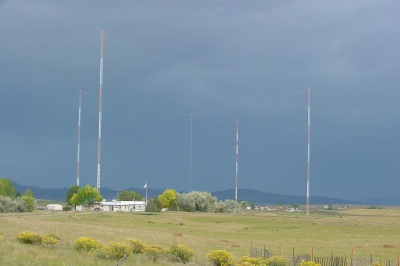WWVB
WWVB is a time signal radio station operated by the National Institute of Standards and Technology (NIST) continuously broadcasts digital time codes on a 60 kHz carrier which serves as a stable frequency reference. The WWVB broadcasts are used by millions of people throughout North America to synchronize consumer electronic products like wall clocks, clock radios and wristwatches. In 2011, NIST estimated the number of radio clocks and wristwatches equipped with a WWVB receiver at over 50 million.
The 70 kW ERP signal transmitted from WWVB is a continuous 60 kHz carrier wave, the frequency of which is derived from a set of atomic clocks located at the transmitter site, yielding a frequency uncertainty of less than 1 part in 1012. Since October 29, 2012, NIST Radio Station WWVB has been broadcasting a phase modulated (PM) time code that has been added to the legacy AM/pulse-width-modulation signal. This enhancement to the broadcast provides significantly improved performance in new products that are designed to receive it. Existing radio-controlled clocks and watches are not affected by this enhancement and continue to work as before.
While most time signals encode the local time of the broadcasting nation, the United States spans multiple time zones, so WWVB broadcasts the time in Coordinated Universal Time (UTC). Radio-controlled clocks can then apply time zone and daylight saving time offsets as needed to display local time.
What is now WWVB began as radio station KK2XEI in July 1956. The transmitter was located in Boulder, Colorado, and the effective radiated power (ERP) was just 1.4 watts. Even so, the signal was able to be monitored at Harvard University in Massachusetts. WWVB went on the air on July 4, 1963 broadcasting a 5 kW ERP signal on 60 kHz. WWVL began transmitting a 0.5 kW ERP signal on 20 kHz the following month, using frequency-shift keying, shifting from 20 kHz to 26 kHz, to send data. The WWVL broadcast was discontinued in July 1972, while WWVB became a permanent part of the nation's infrastructure.
On July 1, 1965 a time code was added to WWVB which made it possible for clocks to be designed that could receive the signal, decode it, and then automatically synchronize itself. The time code format has changed since then and currently uses a decimal time code, using four binary bits to send each digit in binary-coded decimal (BCD).
WWVB transmits data at one bit per second, taking 60 seconds to send the current time of day and date within a century. There are two independent time codes used for this purpose: An amplitude-modulated time code, which has been in use with minor changes since 1962, and a phase-modulated time code added in late 2012.
